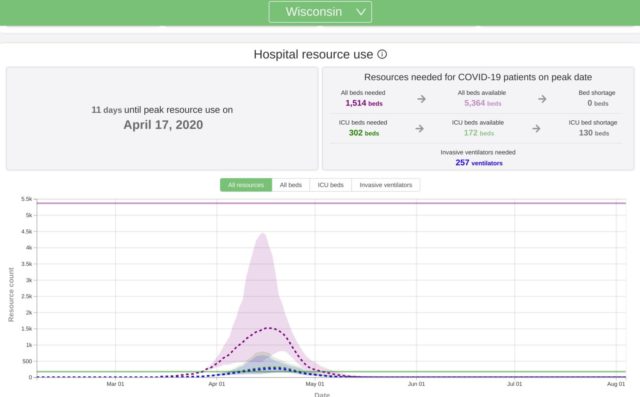The Institute for Health Metrics and Evaluation (IHME) released new data today projecting that hospitalizations due to COVID-19 will peak in Wisconsin on April 15 — two weeks earlier than an update last week and five weeks earlier than the original estimate of May 22, which Madison365 reported on March 29.
The earlier peak estimate indicates that Wisconsin may not be “flattening the curve” as effectively as previously thought.
The projections do not predict a shortage of standard hospital beds, with 1,514 beds needed on April 15 and more than 5,000 available. However, Wisconsin is projected to experience a shortage of 130 intensive care unit (ICU) beds, with 302 ICU beds expected to be needed out of 172 ICU beds expected to be available. The projections also predict Wisconsin will need 257 invasive ventilators on April 15.
The projections predict 32 deaths per day by mid-April, with about 644 total deaths predicted. That’s considerably lower than previous estimates of more than 1,300.
The data do not take into account, however, where beds are located throughout the state, and information on available beds is not broken down by county. This means that local hospitals may see their resources overwhelmed while others see few cases
At the moment, one out of four people who have tested positive in the state have needed to be hospitalized, based on information released by the Wisconsin State Department of Health on Friday afternoon. As of April 4th at 2:00pm when statewide data was made available, 2,267 people have tested positive, which has resulted in 624 hospitalizations. Specific data from Dane County for the number of hospitalizations has not been released. However, as of this morning, the county has a reported 287 positive cases and 9 deaths.
The new IHME projections predict that the United States will hit peak hospital use on April 15, with an estimated daily death rate of 3,130 on April 16th and an estimated bed shortage of 36,654 across the country, including a shortage of 16,323 ICU beds.
For Wisconsin, the expected peak date for resources for the state would hit April 15th which is 4 weeks earlier than its first predicted date of May 22nd as first reported by Madison365 on Sunday, March 23rd and two weeks earlier than IHME’s update on April 1.
These updated models are the result of “substantial changes for several states,” changes in social distancing policies throughout the country, and adjusting the way they estimate uncertainty by weighting the current model with updated data reported by each state, according to IHME’s website. More information about specifics to how this data was adjusted and implemented will be updated tomorrow, April 7.
The data provided by IHME, which last week has been referenced by the White House, the CDC and Johns Hopkins University and used by national, and various state and local governments to frame responses, was first referenced by Madison365 last Sunday. The data is also currently being shared by the Public Health of Madison and Dane County and is currently part of their Data Spotlight.
With a combination of information from each state based on COVID-19 related outbreaks – including information from the American Hospital Association and the World Health Organization, reported death rates, hospital capacity and resources – IHME’s intent is to better prepare area hospitals and administrators and local governments, according to their website. The data is not reliant on available testing since that testing is limited in its availability, but on “observed death rates,” where the likelihood of those who’ve died from the virus have tested positive. These rates, and not reported positive cases or how well a state is testing, is what impacts the actual model.
Though the model does predict the estimated number of cases through August, it does not suggest that pandemic will necessarily end by then. The model itself is focused only on the predicted “first wave” of the outbreak ending sometime in the first week of June. It suggests that current government-mandated social distancing within Wisconsin will still be in place until then. However, IHME points out that 97% of the population will still be susceptible to a second wave if “mass screening, contact tracing and quarantine” and some form of continued social distancing practices are not in place.
There are no indications of when a second wave might hit the country, however.




























